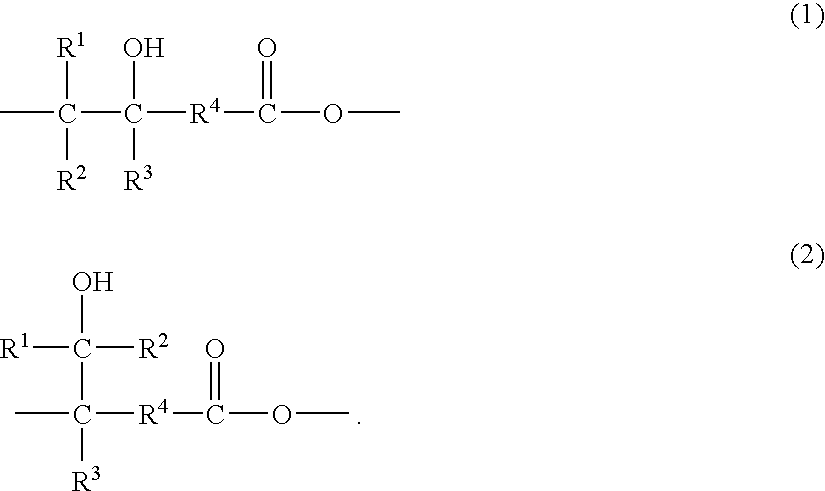Hydroxy-functional polyesters
a technology of hydroxy-functional polyesters and polyesters, applied in the direction of transportation and packaging, synthetic resin layered products, chemistry apparatus and processes, etc., can solve the problems of petroleum present costs and problems, and are unsuitable for a wide variety of applications
- Summary
- Abstract
- Description
- Claims
- Application Information
AI Technical Summary
Benefits of technology
Problems solved by technology
Method used
Image
Examples
example 1
Preparation of a polyhydroxyundecanoate
[0107]A solution consisting of 20 g of 10,11-epoxyundecanoic acid (prepared with the procedure described above) and 10 g of diglyme was heated to 50° C., after which 0.2 g of tetrabutylammonium bromide was added to the solution. The resulting solution was further heated to 150° C. and stirred for 6 hours after which heating was discontinued and an additional 30 g of diglyme was added. The resulting solution was then poured into 1.2 liters of a 2:1 by volume water / methanol solution. A precipitate was formed, which was subsequently filtered off and added to 1.2 liters of a fresh 2:1 by volume water / methanol solution. The thus obtained dispersion was shaken for 24 hours using a reciprocating shaker. The dispersion was subsequently filtered and the filtered residue was allowed to air dry at room temperature for 12 hours, after which the dried residue was dissolved in 100 g tetrahydrofuran. The thus obtained solution was poured into 1.2 liters of a ...
example 2
Preparation of a polyhydroxyundecanoate
[0109]Example 1 was repeated using a higher purity 10,11-epoxyundecanoic acid (99.4% versus 96.4% as determined by epoxide titration). In this preparation, the reaction mixture was stirred for 2.5 hours at 150° C. rather than 6 hours. Additionally, the polymer was washed with acetone. The analysis conducted for the resulting polymer is given in Table 1.
[0110]15 mil thick films of this polymer were prepared by compression molding at 225° F. (107° C.) and 9500 psi (65.5 MPa). The glass transition temperature of these films was determined by dynamic mechanical analysis, which was conducted at a frequency of 1.0 rad / s and a heating rate of 2° C. minute from −150 to 150° C. From this analysis, the glass transition temperature (tan delta peak) was observed to be −8° C. Tensile properties for these films were determined according to ASTM method D882 and are given in Table 2.
[0111]
TABLE 1Properties of polyhydroxyundecanoatesPolyesterPolyesterProperties...
example 3
Preparation and Testing of an Adhesive Film Comprising a polyhydroxyundecanoate
[0113]Films of polyhydroxyundecanoate prepared according to Example 2 were obtained by compression molding at 220° F. and 2000 psi (104.4° C.; 13.8 MPa). T-peel and lap shear samples were assembled with aluminum T2024 or cold rolled steel by placing the polyhydroxyundecanoate film between the aluminum or cold steel substrate materials and pressing at 230° F. and 500 psi (110° C.; 3.4 MPa). The adhesion results are shown in Table 3.
PUM
| Property | Measurement | Unit |
|---|---|---|
| T-peel strength | aaaaa | aaaaa |
| T-peel strength | aaaaa | aaaaa |
| lap shear strength | aaaaa | aaaaa |
Abstract
Description
Claims
Application Information
 Login to View More
Login to View More - R&D
- Intellectual Property
- Life Sciences
- Materials
- Tech Scout
- Unparalleled Data Quality
- Higher Quality Content
- 60% Fewer Hallucinations
Browse by: Latest US Patents, China's latest patents, Technical Efficacy Thesaurus, Application Domain, Technology Topic, Popular Technical Reports.
© 2025 PatSnap. All rights reserved.Legal|Privacy policy|Modern Slavery Act Transparency Statement|Sitemap|About US| Contact US: help@patsnap.com



